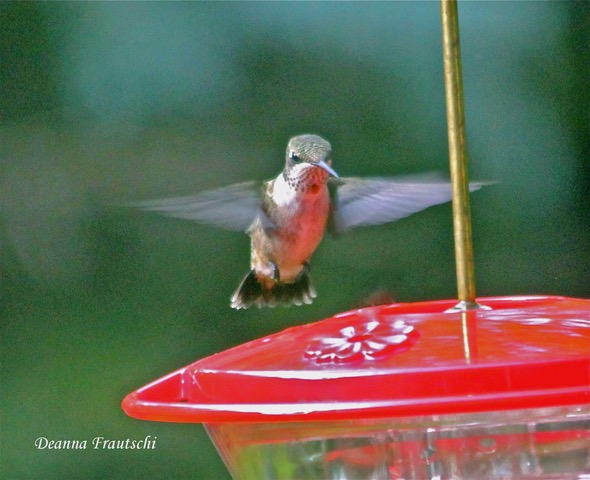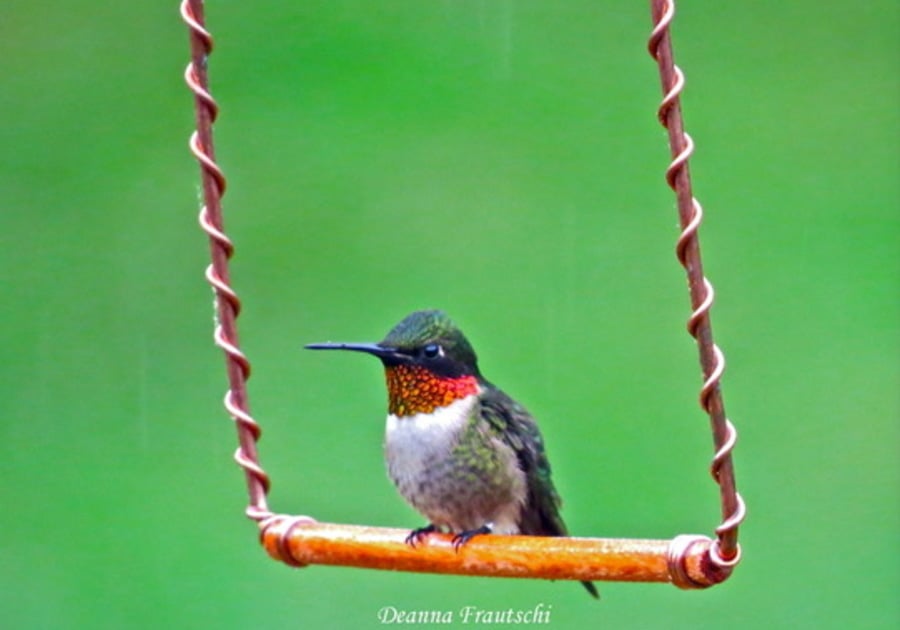“The hummingbird is like a flying jewel,” said the 10-year-old boy excitedly at one of my hummingbird education presentations. His description was perfect for the Ruby-throated Hummingbird which flashes its emerald green feathers and red throat (males) as it darts around flowers and feeders.
The Ruby-throated Hummingbird, the only one we get regularly east of the Mississippi, wings its way back to us each Spring to find food and places to raise young. These tiny birds often travel over 2,000 miles from Central America or Mexico to return to Central Illinois for the summer.
To think of a bird that weighs less than a penny flying that far is amazing. With a body less than three and a half inches and a wingspan of five inches, how does it master this incredible feat? Not to mention its heart is beating over 1200 times a minute and its wings are rotating over 75 times per second as it flies.

Sharing with Your Child
Sharing these flying jewels with your child or grandchild can be as simple as putting a feeder out. Try to have one out by mid-April in Central Illinois. To fill it, simply mix one cup of sugar with four cups of water. Use very hot water or bring just to a boil. Cool. Fill your feeder. Save any extra in the refrigerator so you can refill your feeder every five days or so. Do not use red food coloring. Depending on the age of your children, they may be able to help with this process.
I use only the flat saucer type of feeders now. They don’t drip, are easy to clean, and easy for the hummingbirds to perch on. You certainly want to see them up close after you’ve gone to the trouble of attracting them. Don’t be afraid to hang feeders off roof eaves or on poles attached to deck rails. Just make sure they can spot the red on the feeder.
The males (the ones with the red throat or gorget) arrive first. The females (all white underneath) arrive about two weeks later. After they are both here, courtship is short. The female begins nest building and starts the family quickly. She lays only two eggs at a time. It takes about two weeks for the eggs to hatch and another two and a half for the young to fledge.
By the time the young leave the nest, they are almost as big as the parents. You will notice the difference when they come to the feeders because their feathers are fluffier and the beak and tail feathers are shorter. Then there are the kiddy antics of chasing each other around, chirping as they go.

Think about Flowers
Ruby-throated Hummingbirds' first preference is natural nectar which is sometimes not available in April or early May. Or, there may be too few flowers or too much competition for them. Some of the plants I have used successfully include cardinal flowers, columbine, jewelweed, honeysuckle vine, trumpet vine, and bee balm.
There are many flowers that hummingbirds will sip nectar from but those that have reddish, orange, or pink hues and are tubular are often the best. For more flowers to plant, check out hummingbirds.net. This site will give you lots of good tips about attracting hummers. It even has a migration map so you and your family can track the progress of hummingbirds throughout the United States.

Arrivals and Departures
Although I have had hummingbirds return as early as April 12, the ones who now return to habitat in my yard for the summer usually arrive the first week of May. They are looking for food, water, shelter, and places to raise their young.
Attracting these flying jewels is fun and entertaining for you and your children to watch. If you are lucky enough to get them to habitat in your yard, you will enjoy observing them weekly as they come and go from the feeders. When the young are born, it provides even more fun as the young chase each other around the yard.
Don’t worry about them knowing when to leave in the fall. They typically leave Central Illinois in September and know exactly when to go. Often you will notice them feeding more frequently during this time. Leave your feeder out until two weeks after you’ve seen the last one.

Deanna Frautschi is a local Naturalist who is passionate about connecting families with nature. Using her knowledge of wildlife and her photography skills, she helps others enjoy the nature around them. If you have any questions about exploring nature with your children and grandchildren, you may contact Deanna at Decardinal@aol.com. Join the hundreds who follow her on Facebook where she posts photographs and short video clips of birds and other wildlife taken on her travels as well as in her yard. You can also join her "Hummingbirds Anonymous" Facebook group page.
Story and photos by Deanna Frautschi.



